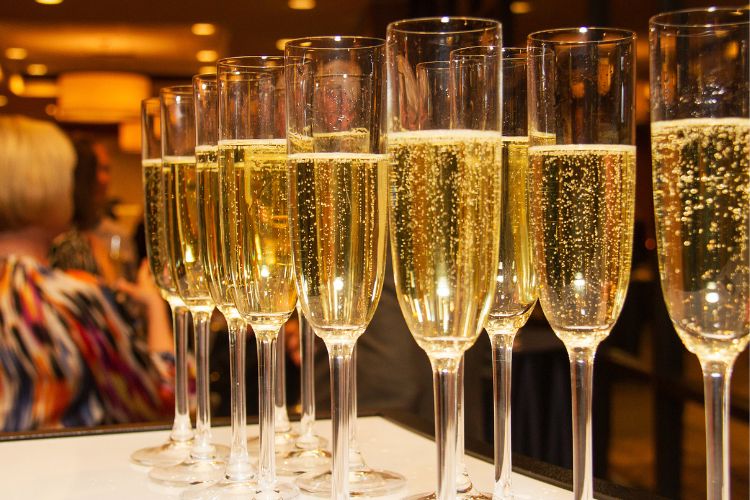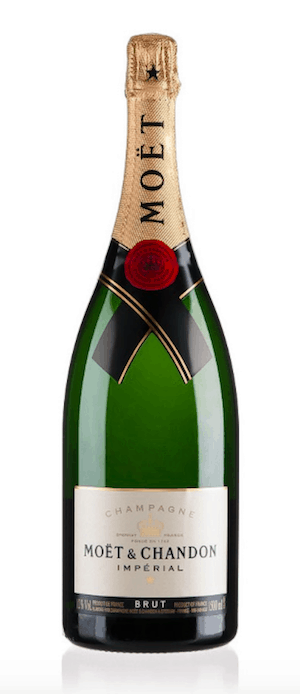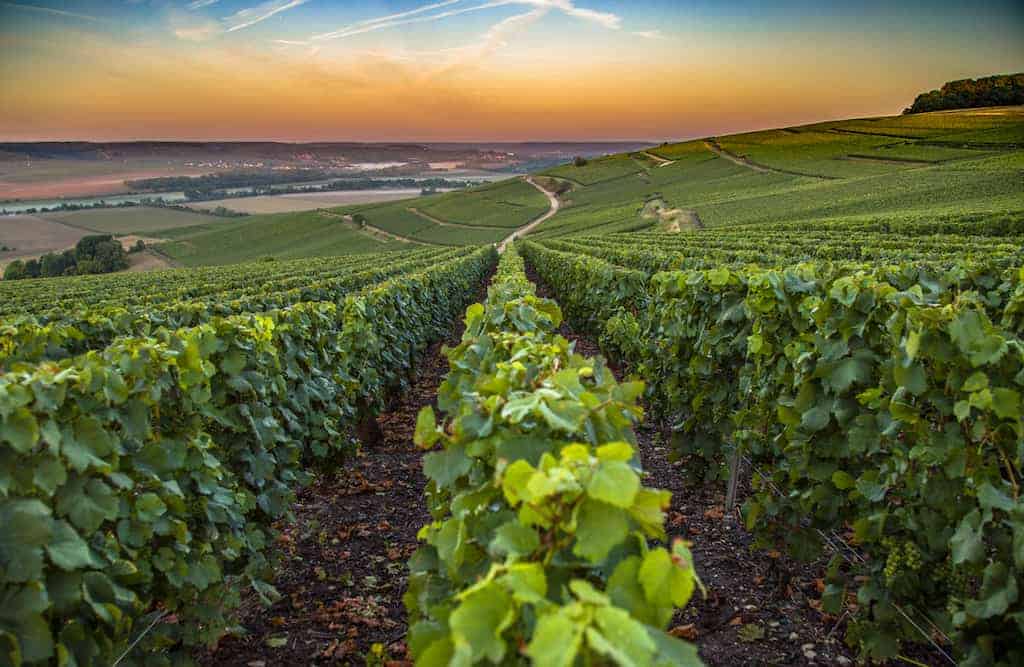In the world of bubbles, it’s important to note that Champagne is just one type of sparkling wine. Real Champagne must come from Champagne, France for it to be labeled as such on the bottle.
Any other sparkling wine isn’t Champagne at all, especially if it’s from somewhere else. In fact, it’s illegal to label a sparkling wine as “Champagne” in many countries unless it originated in Champagne, France and was crafted using permitted techniques in the region.
IN THIS GUIDE:
- Crafting Champagne
- Winemaking & Aging Rules
- Ideal Glasses
- Pricing
- Other Sparkling Wines
- Corks
- Bottle Size
- Brut, Sec and Doux
- Sparkling Wine Recommendations
Crafting Champagne in France
Champagne may display a straw-colored hue, but more often than not, it comes from black grapes– Pinot Noir to be specific. While Pinot Noir is most commonly the grape of choice for champagne production in France, Pinot Meunier and Chardonnay can also be used individually, as in the Chardonnay-only Blanc de Blancs, or as a blend. There’s a simple reason why Champagne made from black grapes isn’t red. It’s because, during the winemaking process, only the flesh of the grape is utilized to craft the wine. While the skins may be black, red or blueish, the flesh inside is white.
Strict Rules for Making Champagne
Grapes used in making Champagne must only come from select pieces of land according to the laws set in place by the Champagne appellation. The method for producing Champagne is dubbed Méthode Champenoise in France. This is also the method that tends to produce the largest and longest lasting bubbles! It entails picking approved grapes that are typically quite unripe with higher levels of structure-building acidity, which gives the base wine a bitter taste at the beginning of the process.
RELATED: A Wine Lover’s Guide to Visiting the Champagne Wine Region
Once the grapes have been picked and undergo an initial pressing, additional sugar and yeast are added to the mix to further enact fermentation. This is done in compact tanks that allow for no exposure to the outside environment. As the yeast digests the tart wine mixture, the organisms release carbon dioxide as a byproduct. Once released, carbon dioxide can’t escape the tanks, thus carbonating the mixture inside and further pressurizing the enclosed environment.
Secondary Fermentation & Aging
Once primary fermentation is complete, a secondary form of fermentation is enacted within the bottle. Additional yeast and rock sugar are added at this point, and this phase of fermentation should last for a minimum of 18 months.
Once aging is complete, the bottles are then turned upside down in a process called “Riddling.” This allows the dead yeast cells, known as “lees,” to settle in the neck of the bottle. Bottles are then rotated daily until the lees fully settle at the top.
At this point, the Champagne bottleneck is then frozen. Once frozen solid, the bottle top is removed, and the solidified lees immediately fly out of the bottle — thus getting rid of any sediment. Once the frozen sediment is ejected, and depending on the brand, additional sugar called a dosage and wine is added to bring the level of fluid back to normal in the bottle. It also helps set the desired amount of sugar content. The bottle is quickly corked to maintain carbonation following this process.

The Best Glasses For Drinking Champagne
There are two main styles of Champagne glass that are most commonly used. The most common is the Champagne Flute, which has a narrow and elongated bowl. When holding the Flute, it’s important to utilize the stem to keep the contents of the glass chilled and safe from the heat of the hand. By using a narrow bowl, carbonation tends to last longer by leaving a smaller gap and less surface area for it to escape.
Other styles of wine glasses are acceptable for drinking Champagne, but they may change what part of the wine is accentuated. While the flute emphasizes the carbonation, using a white wine glass may actually increase the perception of aromas escaping the widened bowl. The Champagne Coupe is a popular choice for Champagne Cocktails, but it allows the bubbles to dissipate at a much faster rate.
Winetraveler Tip: Looking for some great Champagne Glasses? Try out these beautiful Schott Zwiesel Tritan Crystal Glass Champagne Flutes with Effervescence Points
RELATED: Best White Wine Glasses to Use for Different Wine Styles
Why is Champagne So Expensive?
Champagne, above all else, is a quality sparkling wine. Pricing decisions throughout history have considered many variables. Marketing of the region and its wines has always been important and even dates back to the 18th century when Claude Moët was able to convince French royalty that Moët would make a woman more beautiful. Every detail of the wine from the romanticized bottle and gold leaf appearance helped to associate the brand, and many others from the region, with luxury and exclusivity. To this day, Champagne prices are usually higher than other sparkling wines due to many factors including the size of production, quality winemaking standards, and clever marketing techniques.
Other Names for Sparkling Wine (And Where They Come From)
Many countries, both old and new world, produce sparkling wine today. There are a large number of designations, some based on region, others based method. Below are a few more common names for sparkling wine.
- Prosecco (Italy)
- Franciacorta (Italy)
- Asti (Italy)
- Spumante) (Italy)
- Pezsgő (Hungary)
- Sovetskoye Shampanskoye (Soviet Origin)
- Cava (Spain)
- Blanquette de Limoux (Southern France),
- Espumante (Portugal)
- Panciu (Romania)
- Sekt (Germany – though sometimes made with imported grapes from nearby European countries)
- Cap Classique (South Africa)
Different Kinds of Sparkling Wine
There are many different kinds of sparkling made around the world, but there are a few more common versions that standout today.
What is Cava?
Cava is a style of sparkling wine typically produced in northeastern Spain, mostly in the Penedès region. This style of sparkling wine tends to have more of a blend of citrus and tree fruit firmly backed by a chalky minerality and is classified based on aging requirements. Basic Cava is aged for 9 months, Reserva is aged for 15 months, and Gran Reserva Cava is aged for a minimum of 30 months.
These wines are made from Macabeo, Parellada, and Xarel·lo. Macabeo, also known as Viura, is a white grape variety that is known for its delicate aromas and flavors of citrus and green apple. Parellada is another white grape variety that is known for its high acidity and floral aromas. Xarel·lo is a white grape variety that is known for its rich, full-bodied character and flavors of stone fruits and almonds.
In addition to these three main grape varieties, Cava may also contain small amounts of other grape varieties, such as Chardonnay, Pinot Noir, and Subirat Parent. However, by law, at least 50% of the grapes used to make Cava must be Macabeo, Parellada, or Xarel·lo. The specific blend of grape varieties used can vary depending on the producer’s preference and the region in which the Cava is produced.
What is Prosecco?
Prosecco is another style of sparkling wine. There are some critical differences between Champagne, Cava, and Prosecco, but the main difference is in the style of winemaking. Additionally, Prosecco is Italian, while Champagne is French, and Cava is Spanish.
Additionally, Prosecco is primarily made from the Glera grape, which is a white grape variety that is native to the Veneto region of Italy. Glera is known for its high acidity, floral aromas, and fruity flavors. These wines may also contain small amounts of other grape varieties, such as Verdiso, Perera, and Bianchetta. However, by law, at least 85% of the grapes used to make Prosecco must be Glera.
Bottles of Prosecco are typically made to be enjoyed early-on without aging and usually have more tree fruit and tropical fruit-flavors when compared to Champagne, which can give the Italian sparkling wine more “fruitier” characteristics as well. Many Proseccos are made to have Brut level and higher amounts of sugar, resulting in an off-dry bubbly beverage.
What is Crémant?
Crémant is a type of sparkling wine that is produced using the traditional method, similar to how Champagne is made, but outside of the Champagne region in France. The name “Crémant” comes from the French word “crème,” which refers to the creamy texture and delicate bubbles that are characteristic of this wine.
This special sparkling wine is produced in different regions throughout France, including Alsace, Bourgogne, Loire, Jura, and Limoux. Each region has its own set of rules and regulations regarding grape varieties, production methods, and aging requirements.
Crémant is almost always aged on their lees (the dead yeast cells left over from fermentation) for a minimum of nine months, although some producers may choose to age their Crémant for longer periods of time. This aging process adds complexity and richness to the wine, giving it a creamy texture and nutty flavors.
In terms of taste, Crémant is typically dry and crisp, with flavors of green apple, citrus, and pear. The bubbles are fine and delicate, giving the wine a lively and refreshing mouthfeel. Crémant is often compared to Champagne, although it is generally less expensive and more approachable. It is a versatile wine that can be enjoyed on its own or paired with a variety of foods, including seafood, poultry, and cheese.
What is Sekt?
Sekt is a type of sparkling wine that is produced in Germany, using the Charmat or traditional method. It is a popular and affordable alternative to Champagne and is enjoyed by wine enthusiasts all around the world.
It’s made from a variety of grape types, including Riesling, Pinot Blanc, Pinot Gris, and Pinot Noir. German wine regulations dictate that Sekt must be made from grapes grown within the country’s borders.
On the palate, Sekt is generally fresh, fruity, and light, with flavors of green apple, pear, and citrus. It can range in sweetness, from bone-dry to very sweet, depending on the producer and grape variety used. The bubbles are fine and persistent, giving the wine a refreshing and lively mouthfeel.
What is Franciacorta?
Franciacorta is a type of sparkling wine that is produced in the Franciacorta region of Lombardy, Italy. It’s also made using the traditional method, but using different grape varieties and a different aging process.
Franciacorta wines are aged on the lees for at least 18 months, although some producers may age their Franciacorta for up to 60 months. This extended aging process gives the wine a rich and complex flavor, with a creamy texture and delicate bubbles.
This sparkling wine is made primarily from Chardonnay, with smaller amounts of Pinot Noir and Pinot Blanc. The region’s cool climate and hilly terrain, as well as the use of high-quality grapes, give Franciacorta its distinctive flavor and aroma.
Corks Used for Champagne & Sparkling Wine
Agglomerated “twin top” corks are almost always used for Champagne and for many Sparkling Wines. Agglomerated corks are part natural cork, and part synthetic cork. The bottom piece of the cork (touching the wine), is natural. It’s glued to a blend of glue and cork dust. The cork is compressed before inserting it into the bottle in order to make it fit. As the wine ages, this compressed state adheres further to the bottle neck, and agglomerated top tends to mushroom out. In some cases, the longer a Sparkling Wine is aged, the bigger the shroom at the top.
RELATED: Learn About the 5 Different Types of Wine Corks
 Buy a Bigger Bottle of Champagne
Buy a Bigger Bottle of Champagne
The ‘theory’ goes, and we’re stressing theory because it’s not completely scientifically backed (but makes sense), is that the larger the bottle of Champagne, the less oxygen in the bottle. This in turn means that the wine is more pressurized in a magnum, giving it the best size and bubble length. A bigger bottle of Champagne is also better, just based on the fact that you’ll have more Champagne.
Brut, Sec and Doux – What Does it All Mean?
Champagne and sparkling wines are given these sorts of designations depending on the amount of residual sugar left within the wine following fermentation. Some sparkling wines are dry, others are off-dry, some are sweet.
RELATED: Sweet vs Dry Wine – What’s The Difference?
There are 7 levels of dryness as they relate to Champagne specifically, and very often Sparkling Wine as well, depending on region. Here are the levels of sweetness found in Champagne from Driest to Sweetest.
We’re Drinking THIS Sparkling Wine Currently
We love Spanish Cava. As mentioned above, it has a distinct chalky mineral flavor and texture that is difficult to find in any other sparkling wine. We’ve been drinking the 2015 Vintage Juve y Camps Reserva de la Familia Gran Reserva Brut. A stunning value given the quality, depth and complexity of this Traditional Method vintage wine. Check it out while it lasts!

[…] to the people without as hefty a price. These developments have also provided some confusion as to what sparkling wine is – and could or should […]